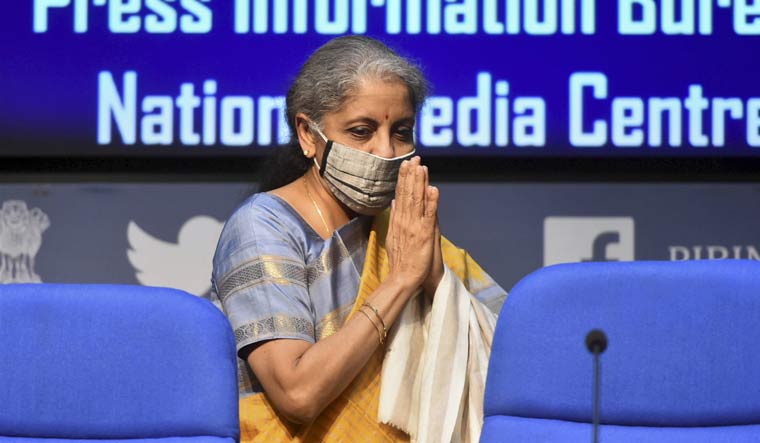Amid the raging farmers protests, Finance Minister Nirmala Sitharaman in her budget speech highlighted the increased money paid to the farmers through the minimum support price for various crops since 2014 when the Modi government came to power. Prime Minister Modi later said the villages and farmers were at the heart of this budget.
As the MSP has been a contentious issue which has led to the farmers protests, Sitharaman gave figures to assure that her government has done more for the farmers than the previous regime.
“Our Government is committed to the welfare of farmers. The MSP regime has undergone a sea change to assure price that is at least 1.5 times the cost of production across all commodities. The procurement has also continued to increase at a steady pace. This has resulted in increase in payment to farmers substantially,” the finance minister said in her speech. She then went on to list the comparative prices paid for wheat, paddy, pulses, and cotton. “In case of wheat, the total amount paid to farmers in 2013-2014 was Rs 33,874 crores. In 2019-2020 it was Rs 62,802 crores, and even better, in 2020-2021, this amount, paid to farmers, was Rs 75,060 crores. The number of wheat growing farmers that were benefitted increased in 2020-21 to 43.36 lakhs as compared to 35.57 lakhs in 2019-20.”
The key announcement for the agriculture sector was levy of Rs 2.5 cess on petrol, and Rs 4 per litere cess on diesel to fund agriculture infrastructure. “There is an immediate need to improve agricultural infrastructure so that we produce more, while also conserving and processing agricultural output efficiently. This will ensure enhanced remuneration for our farmers. To earmark resources for this purpose, I propose an Agriculture Infrastructure and Development Cess (AIDC) on a small number of items,” Sitharaman said.
Interestingly, it was expected that the finance minister would levy Covid cess to generate funds, instead she has proposed the agriculture cess which will be used to create facilities in the rural areas to boost farmers income. Many felt that this has been done to assuage the farmers who have been on the warpath since the three laws were passed in September last.
While Sitharaman tried to assure the farmers that MSP was intact as witnessed through increased amount paid to the former for different crops in the last seven years, she also proposed to make available the Agriculture Infrastructure Fund to agriculture produce market committees (APMCs) for augmenting their infrastructure facilities. The farmers have been alleging that the new laws would deal a body blow to the APMC mandis. As the finance minister allowed fund to enhance facilities in these mandis, it was a signal to famers that government was serious when it asserted that the mandis would not be done away with.
She also raised customs duty on cotton from nil to 10 per cent and on raw silk and silk yarn from 10 per cent to 15 per cent to benefit the farmers.
After the budget, the prime minister said that the budget has many provisions for agriculture sector and increasing farmer’s income. "Farmers will get easy and more credit. Provisions have been made for strengthening APMC and Agriculture Infrastructure Fund. This shows that villages and our farmers are at the heart of this budget.
In slew of steps to support the agriculture sector, Sitharaman announced nine measures as part of inclusive development for aspirational India. She said that the swamitva scheme will be extended to all states, under which a record of rights is being given to property owners in villages.
Another announcement was enhancing the agricultural credit target from Rs 15 lakh crore to Rs 16.5 lakh crore in FY22. Sitharaman further said that the government will focus on ensuring increased credit flows to animal husbandry, dairy, and fisheries.
The budget also raised by 33 per cent allocation for Rural Infrastructure Development Fund from Rs 30,000 crore to Rs 40,000 crore.
The Micro Irrigation Fund has been doubled: with a corpus of Rs 5,000 crore under NABARD, by augmenting it by another Rs 5,000 crore.
For the fisheries sector, Sitharaman proposed substantial investments in the development of modern fishing harbours and fish landing centres. The Finance Minister said that to start with, five major fishing harbours – Kochi, Chennai, Visakhapatnam, Paradip, and Petuaghat – will be developed as hubs of economic activity. Sitharaman also proposed to develop inland fishing harbours and fish-landing centres along the banks of rivers and waterways. This announcement also has been made with an eye on state elections in Kerala, Tamil Nadu, West Bengal, Assam and Pudducherry.
Poll bound Tamil Nadu go another gift as the finance minister said a seaweed park will be established in the state. “It is an emerging sector with potential to transform the lives of coastal communities – it will provide large scale employment and additional incomes.”
She also said that around 1.68 crore farmers are registered in e-NAMs and Rs 1.14 lakh crore of trade value has been carried out through it. Keeping in view of the transparency and competitiveness that e-NAM has brought into the agricultural market, the finance minister proposed to integrate 1,000 more mandis with e-NAM.
Congress leader P. Chidambaram however said the budget was a let down for the farmers.





